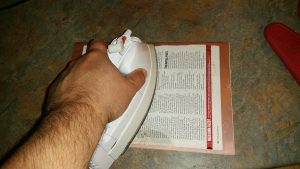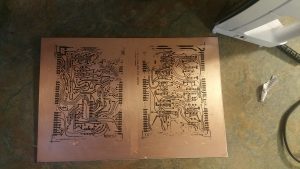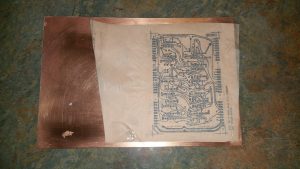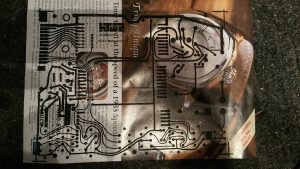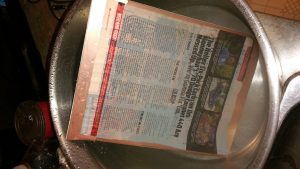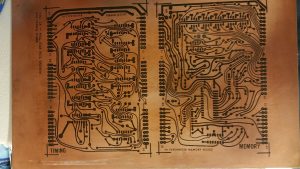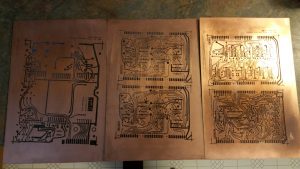So now I’ve got my TV Typewriter ‘artwork’ all finalized and I’m ready to try a transfer. I don’t have any special toner transfer paper — but I do have magazine stock. My first attempt is using pages cut out from a Macleans magazine. The first couple runs are surprisingly easy – the printer takes the sheets and passes them through without fuss. With one sheet done, I decided to take a run at it with the iron and see how the transfer worked. And I had to use iron because I didn’t have a laminator handy — there were none available at any of the stores in town and I was just getting too impatient to get going. Plus, why spend money if you don’t have to, right?
I put the iron on the hottest setting and pressed and ironed for what felt like an eternity but in reality was only about 10 minutes. My arms ached.
I then took the hot PCB (with oven mitts, eventually, after discovering by accident how hot it really was), rinsed it in my sink and peeled off the paper. Damn. Almost.. but still some traces missing.
I spent the rest of the evening trying various things without success. Longer ironing time, more pressure. Started to wonder about the toner I was using — like many, I skimp a bit on that and use remanufactured cartridges. I’ve heard these sometimes have less plastic in them (the stuff that melts), and the result is they don’t transfer as well. But before I go and buy a $200 OEM toner cartridge, I figure maybe I’ll try everything else I can, including changing papers. It’s possible this isn’t going to work — most of the toner transfers via iron I see demonstrated on youtube involve much smaller PCBs.. far easier to apply consistent pressure and heat. But I’m not giving up yet.
I get out some acetone and wipe my test board down. Then I try parchment:
You’d think parchment would a shoo-in — it’s slippery stuff. I thought for sure once heat was applied the toner would just jump right off. Nope. All it did was smudge a little. Argh!
As a last ditch resort, I figured I’d try higher quality paper. By this point I had already ordered Press N Peel, but that’d be a week or more of waiting and I just couldn’t wait that long. I grabbed a Hotrod Magazine from my pile and noticed the paper was just a bit thicker and shinier than the Macleans stock. I gave it a try. I discovered right away though that I had a problem – the traces were not printing at full darkness. They would on regular paper, but not this Hotrod stock. After fooling around for an hour, I realized my issue was that I wasn’t giving the printer the proper setting for printing to glossy paper. What you needed to do was actually tell it you were printing to heavy glossy in Photoshop’s print settings dialog. Doing that caused the printer to request the sheets via the manual feed tray (I had just been slipping them into the regular paper bin, causing the odd error/jam). I noticed right away a big difference — set to heavy glossy, the printer pulls the paper through more slowly, reducing the risk of crease and I guess giving more time for the toner to adhere to the paper properly. The result is fantastic, especially for the really big traces on the motherboard:
In reading online, I also discovered that a lot of people actually fully immersed their transfers in water right after they finished ironing. So I filled up a large corn roasting pot. And after 20 minutes of mad ironing, dunked my ‘transferred’ PCB:
And voila!
Now that I’ve got my ‘technique’ sort of down, I can make more of the boards. With 5 pieces of 200x300m PCB, I’ll make two mainboards, and then on the remaining 3 pieces make 2 each of the cursor, timing and memory boards.
A few days and many sore arms later, here we have it:
Okay.. now I’m getting impatient. I really want to etch. Should I just risk it with the muriatic acid? Hmmm…. 🙂

